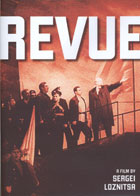
Revue 2008
Distributed by Icarus Films, 32 Court St., 21st Floor, Brooklyn, NY 11201; 800-876-1710
Produced by Filmproduktion, St. Petersburg Documentary Film Studio and MDR
Directed by Sergei Loznitsa
DVD, black and white, 72 min.
College - Adult
European Studies, History, Russia
Date Entered: 12/18/2008
Reviewed by Andrew Jenks, California State University, Long BeachSergei Loznitsa has done a brilliant job scouring Soviet archives in producing this rich collection of propaganda films and news clips from the Soviet Union of the 1950s and 1960s. These clips present a vivid tableau of Soviet society in the era of Nikita Khrushchev, from space flight and folk dancing to the cult of Lenin and calls to root out the enemy. Divided into seven sections, each of which contains numerous short clips, this documentary is ideally suited for classes in Russian history and communism.
The strength of the documentary for teaching, however, may make it less suitable for the casual observer. Having worked in Soviet archives, I appreciate the gargantuan effort involved in gathering together this material. But the director has made little effort to provide a coherent interpretation or narrative. Loznitsa is content to let the material speak for itself, placing the dozens of clips into sections with cryptic titles only those familiar with Soviet history might understand: “March Past, “Factories to Workers,” “Earth to Peasant,” “Forward to Communism,” “Good Luck Children,” “Enemy,” “In the Dark Forest.” Loznitsa does not provide information about the origin, context, and date of the clips, beyond the fact that they all come from the “1950s and 1960s.”
The astute student of history, however, will be able to determine the context and general date of the clips beginning right after Stalin’s death in 1953 and ending with Khrushchev’s ouster in 1964. The material captures the curious combination of primitive and modern attributes in Soviet society: horse-drawn carts spraying chemical fertilizer on collective farms, legions of workers, shovel in hand, followed by newsreels clips about Soviet space rockets. The clips also evoke the intense deprivations of Soviet life following the devastation of World War II, along with the intense longing for peace and consumer goods. Finally, the absence of any image of Stalin and the foregrounding of the cult of Lenin clearly places the material in the context of Khrushchev’s attack on Stalin’s cult of personality.
Despite the absence of explanation and historical context, the documentary is mesmerizing and hypnotic. This viewer had the feeling of being transported to an alternate universe—vaguely familiar with its smokestacks, tractors, and horses—but upon closer inspection almost totally alien.
From a teaching standpoint, the absence of narration and interpretation is a plus. The documentary provides the primary sources which instructors can place into historical context and interpret for students unburdened by the often annoying commentary and wrongheaded interpretations in so many documentary treatments of Russian and Soviet history. The brief clips (most no more than a minute or two long) will stimulate class discussions and provide a powerful supplement to lectures and readings. The general viewer, meanwhile, can take in the whole seventy-two minutes, mesmerized and entertained, no doubt, but also, I imagine, a bit baffled.